I recently came across a local newspaper article describing a new volcanic island, rising from its own ashes above the sea floor, off the coast of Tonga. The subtlety of memory returned me to 1963, and an announcement over our morning radio, of the birth… of a volcanic island off the coast of Iceland. Images, arriving a couple of days later (this was 1963 after all), gave witness to a natural brutality I had not seen before; the sea in boiling turmoil, torn by erupting columns of rock and steam. Beautiful, in an awe-filled way.
It has been fifty years since the cessation of volcanic activity. Surtsey has become home to plants and birds, a laboratory for the adaptable, the dispersible, and the colonial. The only sounds that resonate now are noisy gulls and pounding North Atlantic waves.
Volcanic islands grounded on the sea floor are not unusual, but Surtsey offered a first for intense study, from its violent beginning to the quietude of its sunset. It also has given its name to a specific style of volcanic activity – Surtseyan eruptions (also called phreatomagmatic eruptions) occur when rising magma comes rapidly into contact with shallow seawater or groundwater. The difference in temperature between magma and water is about 1100oC which means the magma solidifies rapidly, but also shatters because of thermal shock. It’s a bit like taking your favourite ceramic baking dish from a very hot oven and plunging it into cold water; the result is a myriad shards, lots of steam, and a sense of annoyance. Surtseyan eruptions are particularly violent, the shattered lava mixing with steam that rises in billowing plumes and projectile-like jets.
Surtsey’s birth was more sedate. It began early November, 1963, with a fissure about 130m deep, from which basaltic magma flowed across the sea floor, building a pile of bulbous, pillow-like lava blobs called, unsurprisingly, pillow lavas. Formation of pillow lavas is a relatively quiet process; it has been observed in action at several subsea locations, and is common in many ancient volcanic deposits. This video link shows magma being extruded as bulbous and tubular pillows (off the coast of Hawaii). Rapid cooling results in a crust of basalt, that in turn is pushed apart by fresh magma. Repetition of this process creates a pile of pillowed basalt. Processes similar to this created the submarine foundations for Surtsey.
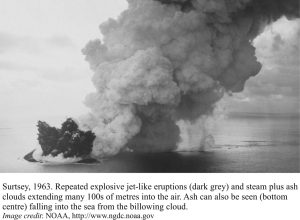 As the lava pile rose to shallower depths, the pressure from overlying seawater decreased to the point where the extruded lava shattered, seawater flashed to steam, and the heated mix was violently erupted as jets and ash columns up to 10 kilometres above the surface. The first people to witness the event were fishermen who first imagined that another ship had caught fire.
As the lava pile rose to shallower depths, the pressure from overlying seawater decreased to the point where the extruded lava shattered, seawater flashed to steam, and the heated mix was violently erupted as jets and ash columns up to 10 kilometres above the surface. The first people to witness the event were fishermen who first imagined that another ship had caught fire.
By mid-November, enough volcanic debris had accumulated on the sea floor to breach the surface. Thus began a contest, between eruptions intent on building an island, and Atlantic waves determined to wash it away. Surtsey had the upper hand, and by mid-April 1965 the 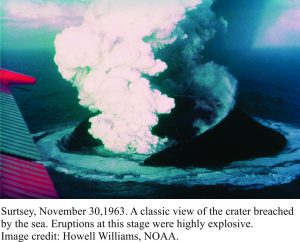 island exceeded a kilometre in diameter. At this stage, the style of eruption changed again; the explosive jets became less frequent because contact between the magma and seawater was less frequent. Eruptions now were relatively quiet lava flows, that when solidified, formed a protective carapace over the softer, fragmental ash and other debris. The solid lava acted as a much stronger buttress to the pounding waves.
island exceeded a kilometre in diameter. At this stage, the style of eruption changed again; the explosive jets became less frequent because contact between the magma and seawater was less frequent. Eruptions now were relatively quiet lava flows, that when solidified, formed a protective carapace over the softer, fragmental ash and other debris. The solid lava acted as a much stronger buttress to the pounding waves.
The video link here has some great scenes from the eruption
The stability of the island has also been enhanced by chemical reactions in the volcanic ash, aided by groundwater at elevated temperatures, that have gradually hardened the softer materials.
There was a temporary lull in activity from May 1965 until August 1966, when lava was again extruded from a new vent. The final stage of the eruption ended in early June, 1967, three and a half years after all the excitement had begun.
Surtsey has been the subject of study almost since its inception. Access is still restricted to those conducting scientific surveys. In 2008, the island was deservedly granted the status of UN Heritage Site, based on its pristine state; for 50 years Surtsey has provided a unique platform to observe the colonisation of its barren, unforgiving landscape, by plants and sea birds. Some of the earliest arrivals were spores carried by winds and the odd bird seeking refuge, and seeds washed ashore. Some of the seeds collected were shown to be fertile, but it wasn’t until 1965 that the first vascular plants (Sea Rocket) established a summer foothold, only to be washed away during the subsequent winter months. The first plants to survive the vagaries of winter were Sandworts in 1968-69. From about 1970 on, the number of vascular plants, mosses and lichens had increased significantly once nesting sea birds began arriving, particularly following a large influx of Gulls in 1986. By 2013, 69 species of vascular plant had established a foothold.
Surtsey will eventually disappear. North Atlantic winds and waves will take turns to reduce the island to a pile of sedimentary rubble. A million years from now, geologists will sample these humble, sedimentary vestiges beneath the sea floor, and wonder…
However, Surtsey’s legacy, even if it doesn’t survive the ravages of deeper time, is illustrated in the more recent, Hunga eruption in Tonga; it too is described as a Surtseyan eruption.
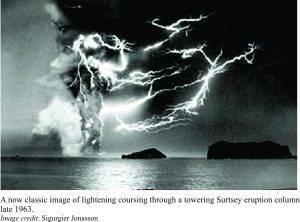
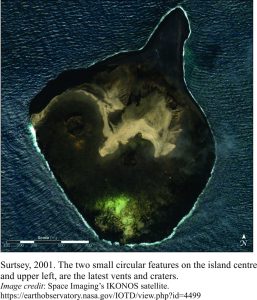
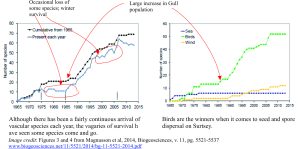
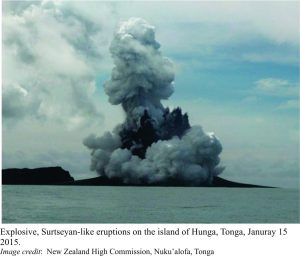


















1 thought on “The brutality of Surtsey’s laboratory”
Pingback: homepage